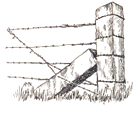Living in the Great American Desert
 One hundred forty years ago, the one-armed explorer and geologist John Wesley Powell drew a long line in the dirt. This survey line, along the 100th meridian, runs north-south through the Dakotas, Nebraska, Kansas, Oklahoma, and Texas. It marked the then-separation point between the arid west and the more humid east.
One hundred forty years ago, the one-armed explorer and geologist John Wesley Powell drew a long line in the dirt. This survey line, along the 100th meridian, runs north-south through the Dakotas, Nebraska, Kansas, Oklahoma, and Texas. It marked the then-separation point between the arid west and the more humid east.
Powell, who lost his arm during the Civil War battle of Shiloh, explored much of the American West. He observed the climate and was wary of allowing settlement in the dry area west of the demarcation line he had identified. The United States government ignored his recommendations. They encouraged the settlement of the West, and today I, and many others, live on the Great Plains.
Here, nothing much will grow without supplemental water because we receive little rain and snow. Our fields must be irrigated with large sprinkler systems. Our lawns, too, have automated watering. We constantly worry about and squabble over water supplies.
A constant influx of people every year means that the same amount of water must be shared by more and more people. They come here to enjoy our abundant sunshine and to escape what one local politician describes as the lawless cities on the west coast.
My water portion inevitably must be reduced. Just yesterday a few of my neighbors and I walked about my neighborhood with a landscaper who specializes in low-water-use designs. We must do something to rid ourselves of acres of thirsty Kentucky blue grass before our local water department cuts off our supply of water for outdoor use.
Yet even with this bleak outlook, I will stay on because I have deep roots here. My people first came to this land in the 1880’s shortly after Powell published his findings. Both my dad’s grandmothers took advantage of the Homestead Act to attempt farming in the west. When faced with scant water supplies and harsh weather, neither had much success:
- Laura Riddle (1853-1933) arrived in McCook, Nebraska in 1885 with three sons in tow. They took a 160-acre homestead near her sister’s family in Red Willow County. Later, Laura moved west to another homestead in Hayes County. When 320-acre tracts became available early in the 20th century, she moved west yet again to Dundy County. Life for her was hard, very hard, and she even had to hand over her only daughter to a sister to raise.
- Anna Petronellia Sherman Reed (1865-1961) homesteaded alone in Wyoming after World War I. She settled northwest of Cheyenne where she detested the wind and treeless landscape. Life for her, too, was difficult on the homestead. One year, her only crop was a bucket of potatoes. She sold her place as soon as she was able to prove it up and moved back to Missouri.
These women came west because they could not make a living elsewhere. Their families stayed on and remain here today. Despite our challenges with water, we hope our leaders can find solutions to the water supply problem. It helps if we each do our part to conserve.
Powell was right that the Great American Desert presents an inhospitable land. Not many have had success with farming here. Ranching and mining presented greater opportunities. Today, climatologists are observing that the dividing line Powell identified may be shifting eastward from the 100th meridian due to climate change. Additional settled areas will face the need to adapt to a dry climate as we have. Powell’s observations about the West were correct.